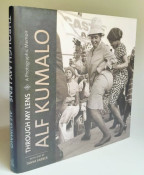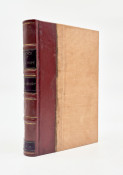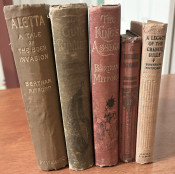A volume from The African Collection. Limited to only 500 copies issued worldwide, hand-numbered #48.
Illustrated, all edges gilt. Long considered one of the classics of big game hunting, this is a handsome deluxe limited edition. In lovely gilt-stamped genuine top-grain cowhide leather binding, all edges gilt, marbled end papers and silk ribbon place marker. Comes with linen-covered slipcase to protect the wonderful leather binding.
In stunning UNREAD condition. Last photo is not part of the listing and not for sale, but is included for your information only.
Frederick Courteney Selous, DSO, was a British explorer, officer, professional hunter, and conservationist, famous for his exploits in Southeast Africa. His real-life adventures inspired Sir Henry Rider Haggard to create the fictional Allan Quatermain character. Selous was also a friend of Theodore Roosevelt, Cecil Rhodes and Frederick Russell Burnham. He was pre-eminent within a select group of big game hunters that included Abel Chapman and Arthur Henry Neumann. He was the older brother of ornithologist and writer Edmund Selous.
Selous was born on 31 December 1851 at Regent's Park, London, as one of the five children of an aristocratic family.
Youth
From a young age, Selous was drawn by stories of explorers and their adventures. Furthermore, while in school, he started establishing personal collections of various bird eggs and butterflies and studying natural history. One account is related by his school master at Northamptonshire when Selous was 10 years old:... on going around the dormitories to see that all was in order, discovered Freddy Selous, laying bare on the floor clothed only in his night shirt. On being asked the cause of this curious behaviour, he replied "Well, you see, one day I am going to be a hunter in Africa and I am just hardening myself to sleep on the ground."
His love for natural history led him to study the ways of wild animals in their native habitat. His imagination was strongly fuelled by the literature of African exploration and hunting, Dr. David Livingstone, and William Charles Baldwin in particular.
African exploration
Going to South Africa when he was 19, he travelled from the Cape of Good Hope to Matabeleland, which he reached early in 1872, and where (according to his own account) he was granted permission by Lobengula, King of the Ndebele, to shoot game anywhere in his dominions. From then until 1890, Selous hunted and explored over the little-known regions north of the Transvaal and south of the Congo Basin (with a few brief intervals spent in England), shooting African elephants and collecting specimens of all kinds for museums and private collections. His travels added greatly to the knowledge of the country now known as Zimbabwe. He made valuable ethnological investigations, and throughout his wanderings—often among people who had never previously seen a white man—he maintained cordial relations with the chiefs and tribes, winning their confidence and esteem, notably so in the case of Lobengula.
In 1890, Selous entered the service of the British South Africa Company, at the request of magnate Cecil Rhodes, acting as guide to the pioneer expedition to Mashonaland. Over 400 miles of road were constructed through a country of forest, mountain, and swamp, and in two and a half months Selous took the column safely to its destination. He then went east to Manica, concluding arrangements which brought the country there under British control. Coming to England in December 1892, he was awarded the Founder's Medal of the Royal Geographical Society in recognition of his extensive explorations and surveys, of which he gave a summary in a journal article entitled "Twenty Years in Zambesia".
Military career
Selous returned to Africa to take part in the First Matabele War of 1893 and was wounded during the advance on Bulawayo. It was during this advance that he first met fellow scout Frederick Russell Burnham, who had only just arrived in Africa and who continued on with the small scouting party to Bulawayo and observed the self-destruction of the Ndebele settlement as ordered by Lobengula.
Selous returned to England, married, and in 1896 he returned to Africa with his wife and settled on a landed property in Essexvale, Matabeleland, overlooking the Ncema River. When the Second Matabele War broke out, Selous took a prominent part in the fighting which followed, serving as a leader in the Bulawayo Field Force, and published an account of the campaign entitled Sunshine and Storm in Rhodesia (1896). It was during this time that he met and fought alongside Robert Baden-Powell, who was then a Major and newly appointed to the British Army headquarters staff in Matabeleland.
In the First World War, at the age of 64, Selous rejoined the British Army and saw active service in the fighting against German colonial forces in the East Africa Campaign. On 23 August 1915, he was promoted to Captain in the uniquely composed 25th (Frontiersmen) Battalion, Royal Fusiliers, and on 26 September 1916 was awarded the Distinguished Service Order, the citation reading: Capt. Frederick Courteney Selous, Royal Fusiliers. For conspicuous gallantry, resource and endurance.He has set a magnificent example to all ranks, and the value of his services with his battalion cannot be over-estimated.
Death and legacy
On 4 January 1917, Selous was fighting in the bush war on the banks of the Rufiji River against German colonial Schutztruppen, outnumbered five-to-one. That morning, he was creeping forward in combat during a minor engagement when he raised his head and binoculars to locate the enemy. He was shot in the head by a German sniper and was killed instantly.Upon getting the news, American president Theodore Roosevelt (his close friend) wrote:He led a singularly adventurous and fascinating life, with just the right alternations between the wilderness and civilization. He helped spread the borders of his people's land. He added much to the sum of human knowledge and interest. He closed his life exactly as such a life ought to be closed, by dying in battle for his country while rendering her valiant and effective service. Who could wish a better life or a better death, or desire to leave a more honourable heritage to his family and his nation?He was buried under a tamarind tree near the place of his death, at Chokawali on the Rufigi River, in today's Selous Game Reserve, Tanzania, in a modest, flat stone grave with a simple bronze plaque reading: "CAPTAIN F.C. SELOUS D.S.O., 25TH ROYAL FUSILIERS, KILLED IN ACTION 4.1.17."
Selous as a hunter
Selous is remembered for his powerful ties, such as those with Theodore Roosevelt and Cecil Rhodes, as well as for his military achievements and the books that he left behind. But he is best remembered as one of world's most revered hunters, as he pursued big-game hunting in his southern African homelands and in wildernesses worldwide.Accounts of his youth are filled with stories of trespassing, poaching, and brawling, almost all within romanticised and humorous portrayals, but one in particular from 1870 stands out as more serious: when in Wiesbaden, Prussia, he knocked unconscious a Prussian game warden who tackled him while stealing buzzard eggs for his collection, and had to leave the country at once in order to avoid imprisonment. Then he moved to Austria, and in Salzburg he went big game hunting for the first time in the nearby Alps, where he shot two chamois.
On 4 September 1871, at the age of 19, he left England with £400 in his pocket, determined to earn his living as a professional elephant hunter, and by the age of 25 he was across South Africa as one of the most successful ivory hunters of the day.
Selous journeyed in pursuit of big game to Europe (Bavaria, Germany in 1870, Transylvania, then Hungary but now Romania in 1899, Mull Island, Scotland in 1894, Sardinia in 1902, Norway in 1907), Asia (Turkey, Persia, Caucasus in 1894-95, 1897, 1907), North America (Wyoming, Rocky Mountains in 1897 and 1898, Eastern Canada in 1900-1901, 1905, Alaska and Yukon in 1904, 1905) and the "dark continent" in a territory that extends from today’s South Africa and Namibia all the way up into central Sudan where he collected virtually every specimen of all medium and large African mammal species.
On 2 May 1902 Selous was elected Associate Member of the Boone and Crockett Club, a wildlife conservation organisation founded by Theodore Roosevelt and George Bird Grinnell in 1887.
In 1909-1910, Selous accompanied American ex-president Roosevelt in his famous African safari to British East Africa, the Congo, and Egypt.
Roosevelt wrote of Selous: Mr Selous is the last of the big game hunters of Southern Africa; the last of the mighty hunters whose experience lay in the greatest hunting ground which this world has seen since civilised man has appeared herein.
In 1909, Selous co- founded the Shikar Club, a big-game hunters' association, with two other British Army Captains, Charles Edward Radclyffe and P. B. Vanderbyl, and regularly met at the Savoy Hotel in London. The association's President was The 5th Earl of Lonsdale; another founding member included the artist, explorer, and Selous biographer John Guille Millais.
He was a rifleman icon and a valued expert in firearms. Early in his hunting career, in the mid-1870s, Selous favoured a four bore black powder muzzleloader for killing elephant, a 13 lb short-barreled musket firing a quarter-pound bullet at with as much as 20 drachms (550 gr; 35 g) of black powder, one of the largest hunting caliber fabricated. Between 1874 and 1876 he killed seventy-eight elephants with that gun, but eventually there was a double loading incident together with other recoil problems from it, and he finally gave it up as too "upsetting my nerve". He used a ten-bore muzzleloader to hunt lions.After black powder muzzleloader firearms became obsolete, he adopted a breech-loading 10 bore as shown in "A Hunters Wanderings in Africa" and by 1880 he was using his favourite, black powder breech-loading rifle, a 461 No 1 Gibbs / Metford / Farquharson single shot later he was approached by both Birmingham and London gunmakers in hopes of his endorsement, with Holland and Holland providing two Holland and Woodward patent single-shot rifles (often confused in photos as Farquharson's) in the two calibres: a 303 and a 375 2 1/2" and later a .425 Westley Richards bolt action rifle. There are quotes as to how Selous was not a crack shot, but a rather ordinary marksman, yet most agree that was just another personal statement of modesty from Selous himself. Regardless, he remains an iconic rifleman figure and, following in the tradition of others, the German gunmaker Blaser and the Italian gunmaker Perugini Visini chose to name their top line safari rifles the Selous after him.
Naturalist and conservationist
Many of the Selous trophies entered into museums and international taxidermy and natural-history collections, notably that of the Natural History Museum in London. In their Selous Collection they have 524 mammals from three continents, all shot by him, including 19 lions. In the last year of his life, while in combat in 1916, he was known to carry his butterfly net in the evening and collect specimens, for the same institution. Overall, more than five thousand plants and animal specimens were donated by him to the Natural History section of the British Museum. This collection was held from 1881 in the new Natural History Museum in South Kensington (which became an independent institution in 1963). Here, posthumously in 1920, they unveiled a bronze bust of him in the Main Hall, where it stands to this day. He is mentioned widely in foremost taxidermist Rowland Wards catalogues for world's largest animal specimens hunted, where Selous is ranked in many trophy categories, including rhinoceros, elephant and many ungulates. He was awarded the Royal Geographical Society's Founder's Medal in 1893 "in recognition of twenty years' exploration and surveys in South Africa".In 1896, British zoologist William Edward de Winton (1856–1922), named a new African small Carnivora, Paracynictis selousi or the Selous mongoose, in his honour. Also, a subspecies of the African Sitatunga antelope, (Tragelaphus spekii selousi), bears his name. Selous was one of the first hunter-conservationists. In none of his expeditions was his object the taking of a big bag, but as a hunter-naturalist and slayer of great game he ranked with the most famous in the world. In leading so many hunting expeditions, Selous noticed over time how the impact of European hunters was leading to a significant reduction in the amount of game available in Africa. In 1881 he returned to Britain for a while, saying; Every year elephants were becoming scarcer and wilder south of the Zambezi, so that it had become impossible to make a living by hunting at all.
- Sold By: Springbok Books
- Contact Person: Wade Burgess
- Country: United States
- Email: [email protected]
- Telephone: 1-505-382-2875
- Preferred Payment Methods: Wire or bank transfer / Money order / Bank check / Personal check / PayPal with a 5% surcharge / PayPal Friends & Family at 0% surcharge
- Trade Associations: AA Approved

Similar lots in the current auction View all
Click on an item to view more details and to bid.


















.jpg)








